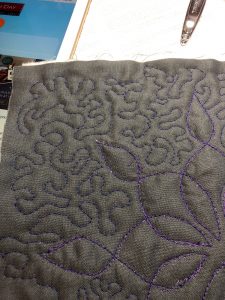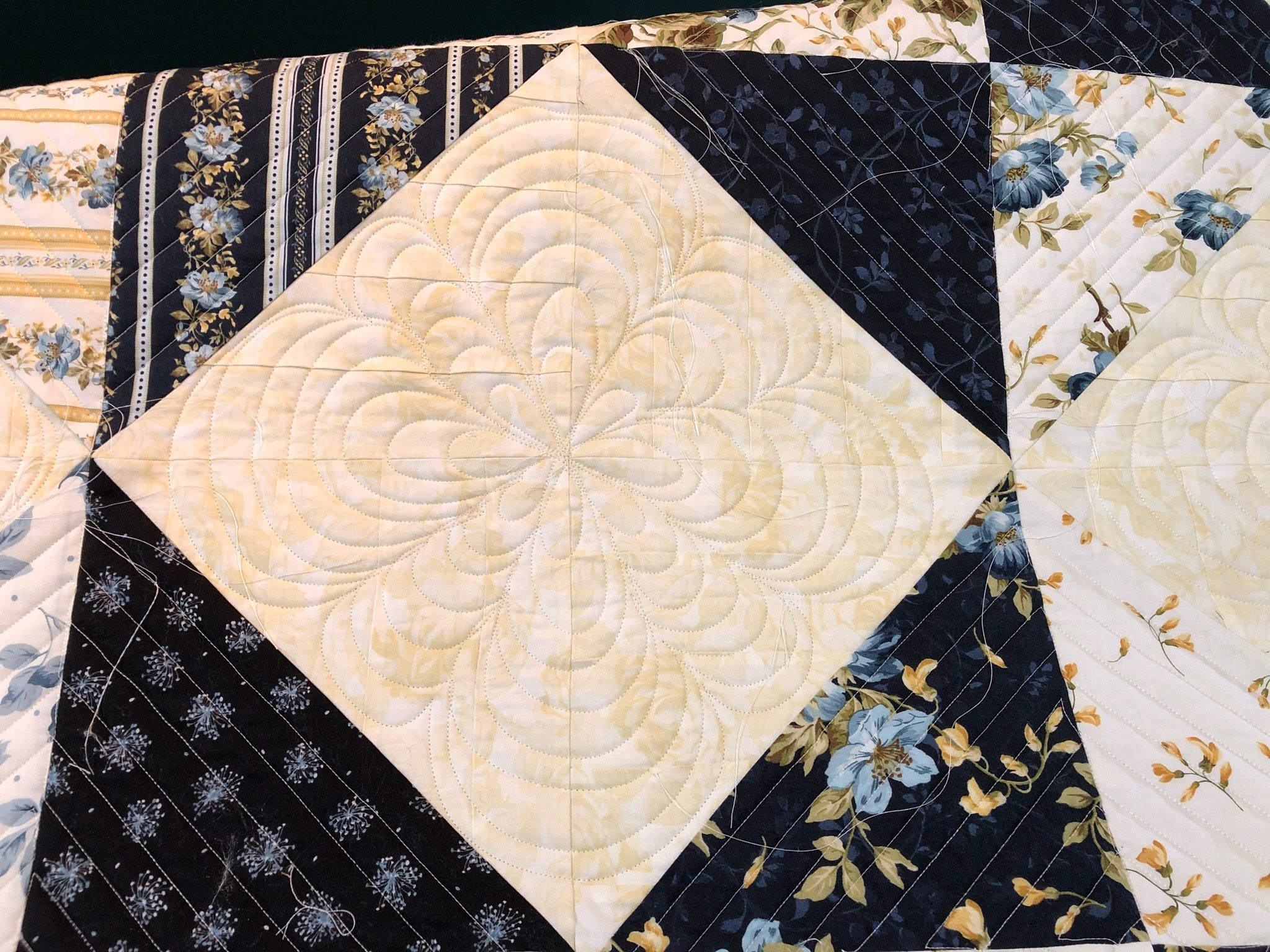It's amazing to me how something that seems like it should be pretty quick can become never ending. A not insignificant part of the never ending moving is that I am no longer 26. I can't haul boxes down flights of stairs as quickly, for as long, nor as efficiently as I could before. The fact that the moving isn't finished hasn't stopped me from sewing, but sewing takes much longer because I have to go upstairs for things that haven't been moved yet. It also takes longer because things are not set up efficiently yet.
Which brings me back to The Quilter's Academy. I have worked my way through the first 4 chapters, which are about setting up your space and acquiring tools. I have started getting my space and tools together, but I want to share pictures and I can't really do that yet. However, my general opinion of this section is good. As with all things, it's important to keep your own preferences in mind. What you like working with is more important than the author's suggestions. For example, I like my work areas more spread out than other people may. It forces me to move around which is important for me. My mother likes to have a pressing surface and a cutting surface she can swivel her chair (or herself) to so she doesn't have to get up. 'You do you' is REALLY important to your enjoyment of the process.
I'd like to talk about sewing machines first (not the order in the book) The book discusses types of machine and places you can acquire them on any budget. Sewing machines can be very expensive. Cheap machines are readily available, but come with some draw backs. Often the lower quality of cheap machines can become expensive, if the machine needs frequent repair work or replacement with a new machine. Some old machines, while high quality when they were new are not worth purchasing used. I had a used machine that was great when new, but the gears were made of type of plastic and after a certain time the gears deteriorated and, as they were no longer made, couldn't be replaced. We found this out after we had some regular maintenance done. The black powder that was one some things I sewed wasn't from the black velvet I had been sewing, it was the gears inside falling, literally, to dust. To make things even more fun some of these models had gears made from a different plastic, which didn't have this problem.
Some of the sewing machines recommended in the book are no longer available and there are machines currently available that weren't available when the book was written.
Finding a used machine is a good way to go, if you know a little something about them. If you are new to sewing it's hard to tell if that good deal really is a good deal AND if the problem you are having is your inexperience, or that the machine needs to be adjusted. We went on a shop hop (these are great fun - I highly recommend them) and at one of the shops a lady had brought in her machine because she was having tension issues. During a brief conversation between the quilt shop owner and the quilter I learned A LOT of things I didn't know. Were you aware that machines should always be threaded (up to the needle) with the presser foot in the up position? I always did it this way, because it's the way I was taught. Turns out that the tension on the thread doesn't set correctly on some machines if the presser foot isn't up. For a new sewer this could cause a significant amount of frustration.
Some good places to find a used machine: store that sell and service machines will sometimes take old machines in trade on new, some servicers will buy used machines and fix them up for sale.
Goodwill and Salvation Army stores have them, but not too often. You often have to take machines from Goodwill and Salvation Army on faith. They aren't tested and you often can't try before you buy. Other options include
Ebay and
Craigslist. If you get a used machine from someone other than a servicer plan to take them in for a tune-up and service after purchase. When I've had my machine tuned up it generally cost around $100. Some people recommend having your machine tuned up every year, other people recommend only having service done if your machine is having some trouble. I'm in the second camp. I don't get servicing done unless there is a problem. I am pretty dutiful about oiling my machine and replace the needles fairly often.
One machine that I recommend for consideration is
Ever Sewn. This is a newer brand (at least to me). It is on the less expensive end, but is decent quality for the price. I bought one a year or so ago. I was trying to do machine quilting and I couldn't get my, higher end, old machine to work.
My older machine is a hand-me-down from my mother. She bought it new years ago and didn't like it as much as she thought she would. It's a New Home (
Janome) Memory Craft and cost (as I recall) around $3,000 when she bought it. It is a great machine and sews well. It does embroidery (using computer program cards, which aren't available anymore). I've sewn clothes and many quilt blocks with it. I use the embroidery function to personalize things and for knitting needle cases.
The manual has a section about quilting with the machine. So I thought I'd give it a try. I was unsuccessful. The underside of the quilting was a nest of tangled threads, no matter what I did. Prior projects I'd tried quilting had also been unsuccessful and I'd read everything I could find about how to use your domestic machine for quilting. This was probably my 23rd attempt.
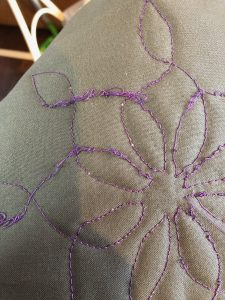
As an experienced quilter/sewing machine user, this was incredibly frustrating. In fact, I had considered giving up trying to learn to do machine quilting. (Luckily I didn't give up) I talked to the Janome dealer local to me, I hit the internet (as you do)- trying to find some help. I even watched a couple videos. I saw that
Leah Day had a blog post about Ever Sewn machines. Leah Day is a rich source of information about quilting and I am sure to post lots of links to her site, especially her information on free-motion quilting on a domestic machine. Further internet research followed and off I went to
Missouri Star Quilt Company, since not only did they have the machine, they were having a sale. It's 1.5 hours away, so not a trip for the faint of heart, but not so far it's out of the question.
Four hours (more or less) later I was home with this (the is my old sewing room set up):
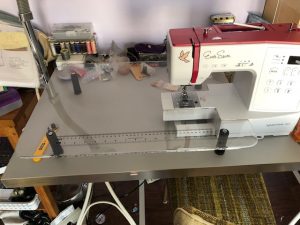
This little machine resulted in the following (and you can see a bit of Leah Day's site on my iPad in this picture).
The only change in the two samples is the machine (the lighter thread in this picture is the quilting from the old machine, I trimmed off the nests but didn't pull out all the prior stitching). And the expensive machine did NOT do a better job and the and it wasn't user error. A new quilter would be more likely to think they were doing something wrong and give up.
If you have some experience with sewing machines or have a friend or family member who can offer assistance a used machine is definitely a good option. But if you don't have experience or a helpful person to offer assistance I think it's pound foolish to take a chance on a used machine. You just never know what you're getting.
I also agree with the Quilter's Academy: spending money on a cheap new machine from a big box store is an iffy proposition. Why set yourself up for possible frustration when you're already taking up a totally new craft? As a long-time and experienced sewer I wouldn't buy a cheap machine from a big box store. Do your research, learn as much as you can about the machines you are interested in, read reviews of machines (there are a lot of them out there), most dealers will let you try out the machine before you buy (not an option at places like Walmart) and buy the best machine you can reasonably afford that is appropriate for your intended purpose.
If you have to buy a cheaper machine because you can't afford your dream machine that's okay too. I really want a new
Pfaff. I bought a new one about 20 years ago. It was a great machine, but they don't last forever, especially when you sew nearly every day. I would love to have another - some day. But right now the Ever Sewn was the best I could afford at the time and has performed very well. Do I still want a Pfaff - you bet I do. The Ever Sewn is still a great machine and I'm happy with it.
My only other commentary is to accept that not every machine works for every person. The reason I have the Janome is that my mother can NOT sew with it. For me, other than quilting, it sews like a dream. She once gave me a used Viking, she loved it. I had nothing but trouble. I couldn't sew 1 inch without it breaking the thread. New needles, a trip for servicing, different thread brands and weights - still had the same problem. Mother would come visit and use it - sewed like a dream. She'd get up and I'd sit down - nothing but trouble. I have no idea why. But if you try several machines and find you have a much better experience with a machine you can't afford, put it on your 'some day' list and save up while you build your skills.
In closing here is a picture of the most recent quilt I quilted (on the long arm). The maker was very pleased with how it came out, and that IS the main goal.
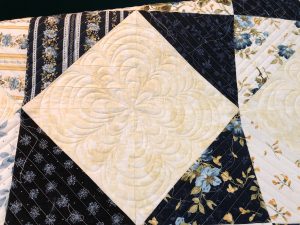
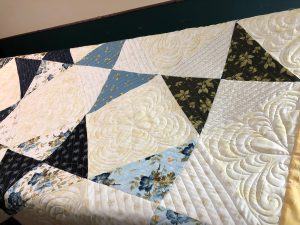
Next week - Cutting tools.


